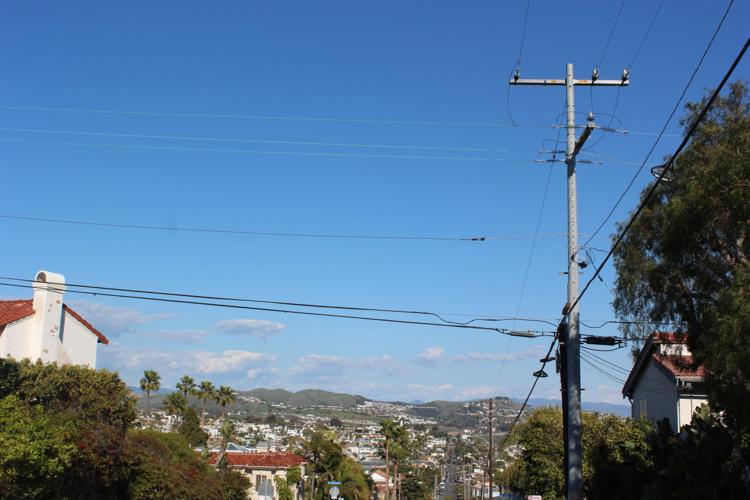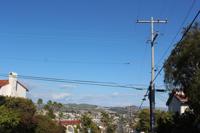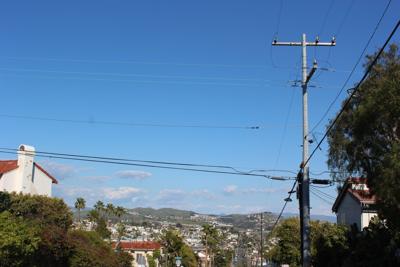The first neighborhood in Dana Point has begun the process to potentially underground its overhead utilities.
Fifty-nine homes between Selva Road and La Cresta Drive along Chula Vista Avenue are in the proposed area in which utilities would be undergrounded, seeking to form an Underground Utility Assessment District. Formation of the district is the first step in evaluating the feasibility of undergrounding its overhead utilities.
Though city policy states that residents must bear the costs to implement an undergrounding assessment district, the Dana Point City Council voted unanimously on Tuesday, March 19 to approve a one-time exception to the policy.
For the first neighborhood to begin the first phase, the city will foot the bill for a consultant to complete the first phase of the undergrounding assessment district formation.
Public Works Director Matt Sinacori explained that the request to form the first undergrounding assessment district is a “very positive thing for the city. It’s the area up in the Lantern Village; it’s Chula Vista/Blue Lantern area.”
Sinacori explained that he and City Manager Mike Killebrew have realized that the city’s policy advising residents on how to underground utilities is complex and difficult to interpret. Because of this, staff suggested that the city “walk the public through the first time this was applied to an undergrounding assessment district.”
Killebrew added that by covering the cost of consultant fees incurred in forming the underground assessment district, the city can “get educated for the first one.”
“I would like to bring back, in the next month or so, an update and some clarifications in the policy just to make it a lot simpler,” Killebrew said. “Going forward, these up-front costs in accordance with the current council policy would be for applicants to come up with this initial $15,000.”
After a Chula Vista property owner submitted interest in forming an assessment district and proposed boundaries for the area in which utilities would be undergrounded, the next step in forming the district is for the city to contract a consultant to prepare and submit a boundary map to utility companies, according to the city’s current step-by-step guide to utility undergrounding.
Once the boundary map to the assessment district is accepted, the utility company would provide a cost estimate and a petition would then be circulated to affected property owners within the assessment district boundaries. At least 60% of property owners in the district must sign in support of undergrounding utilities for the process to move forward.

Dana Point’s Chula Vista Neighborhood is starting the long process of undergrounding its overhead utilities in collaboration with the city, to test the feasibility of establishing an assessment district. Photo: Breeana Greenberg
Councilmember Mike Frost added that in addition to helping to clarify the process to staff and update the city’s guiding document on the process, the benefit of helping the first neighborhood through district formation process is that “for the other parts of the community, there’s going to be a tangible bid document or whatever that sort of tangible packet is at the end of this, that Blue Lantern, Chula Vista get to walk around to all of their neighbors.”
“It’s going to be specific to Blue Lantern and Chula Vista, but, really, any other group in the city can reference that and acknowledge that their prices are going to be different, but at least they can see, ‘Hey look, this is the tangible document that we will get back if we put in 15, 20 grand,’ ” Frost continued.
For residents coming to the city asking for guidance on how to form an assessment district, Frost noted that city staff can share the process and policy, as well as refer back to the information gained from the assessment district engineering in this first neighborhood.
Mayor Jamey Federico added that helping this first neighborhood through the first phase in the undergrounding process “is important to do for our own learning and because this is important proof of concept.”
“If power lines are going to go down in residential neighborhoods in this city, this is a part of how it gets done, and for us to have something on file that we can help get people, we’ve said that we need to take a leadership role in doing this, so this is one more thing we can do to help other neighborhoods that might want to do this,” Federico continued.
Federico said that though the city is working on undergrounding utilities on main arterial streets, “in order for this to get done in residential neighborhoods, this is how it has to happen, and we need to be able to help and give them all of the tools to make it as easy as possible.”
In response to the city approving the one-time cost to form the first assessment district, Poles and Lines Coalition Founders Marilyn and Len Gardner said the news was “a ray of hope.”
“We, of course, would love to have a municipality or county or the state, or better yet, the utility companies help residents do this, but I think in the absence of that … it’s great to see the 59 houses involved take their own initiative to do this,” Marilyn said. “It will set a precedent, but more than that, an example to other streets and when people see that happening, they’re going to want to do it.”
Len added that it’s heartening to see residents “getting involved and making that commitment to improve their neighborhood, even though there’s some personal cost to themselves. How much, that cost remains to be determined … but in any event, it’s important that it happens. It’s an important thing for the safety of the community.”
Marilyn noted that not only do utility poles and lines pose safety risks in the event that they fall or spark fires, they also obstruct views throughout the city.
“It’s old-fashioned, wires everywhere,” Marilyn said. “It’s something we put up a long time ago, and it’s time to take them down. If nothing else, the environment is telling us it’s time to take them down, because the actual risk has gone up for fire.”
Len added that with high winds, fallen utility poles and lines can cause fires and property damage.
“Like Marilyn says, it’s a legacy of the last century and even the century before,” Len said. “It’s time to move on from that.”
During the March 19 meeting, Councilmember John Gabbard added that he’s gone through the underground assessment district formation process twice with different properties that he’s owned, noting that it is a “laborious process."
“I just ask everybody to remember that this is going to be a long, long process; it doesn’t happen overnight,” Gabbard said. “Even once it’s formed and all of the paperwork is done, it takes even longer to get the poles out of the ground, get the wires in the ground.”





